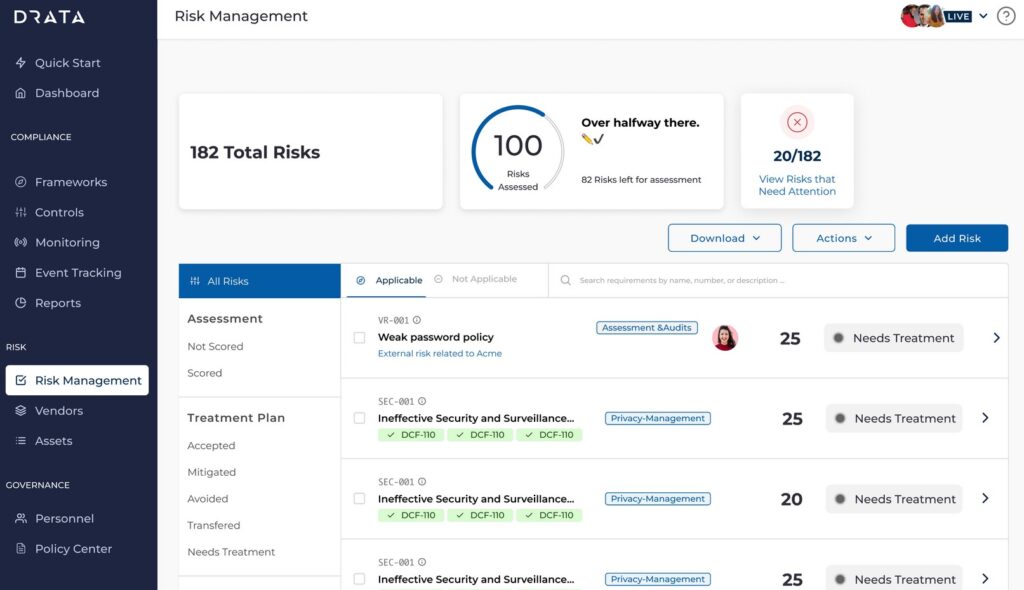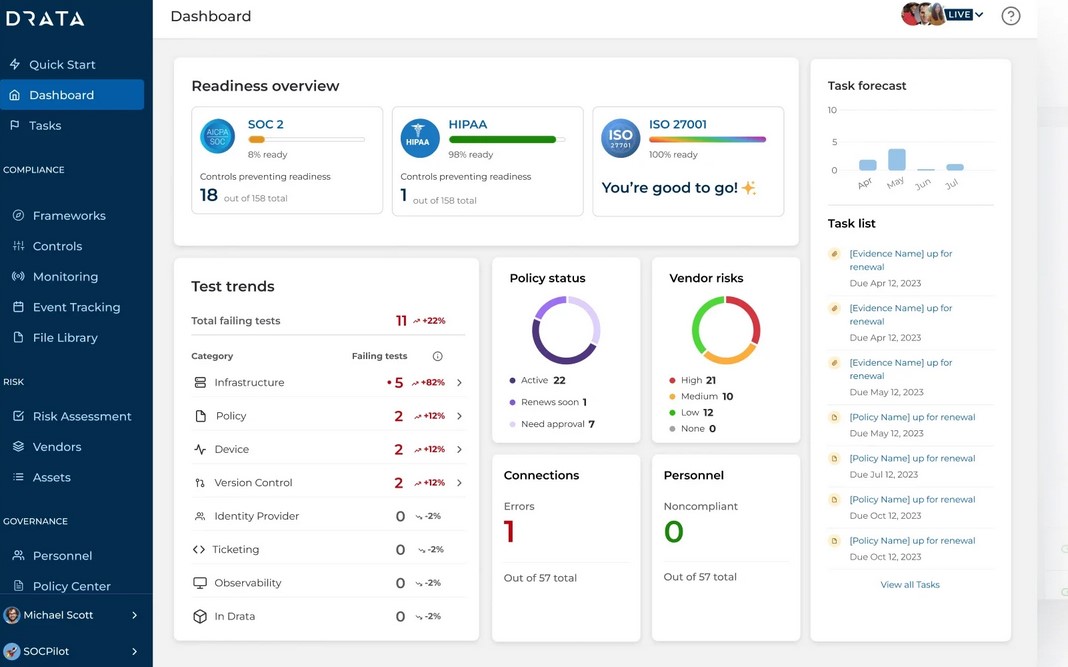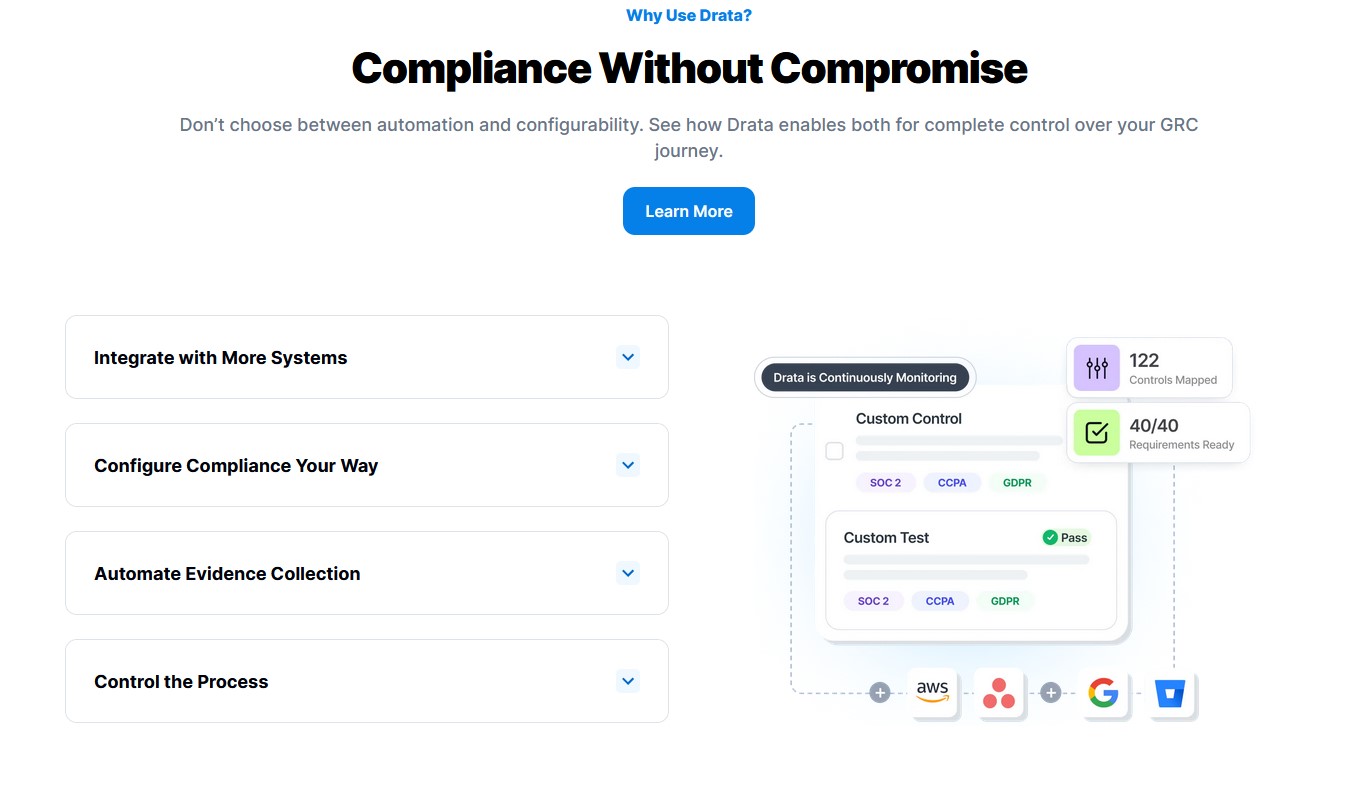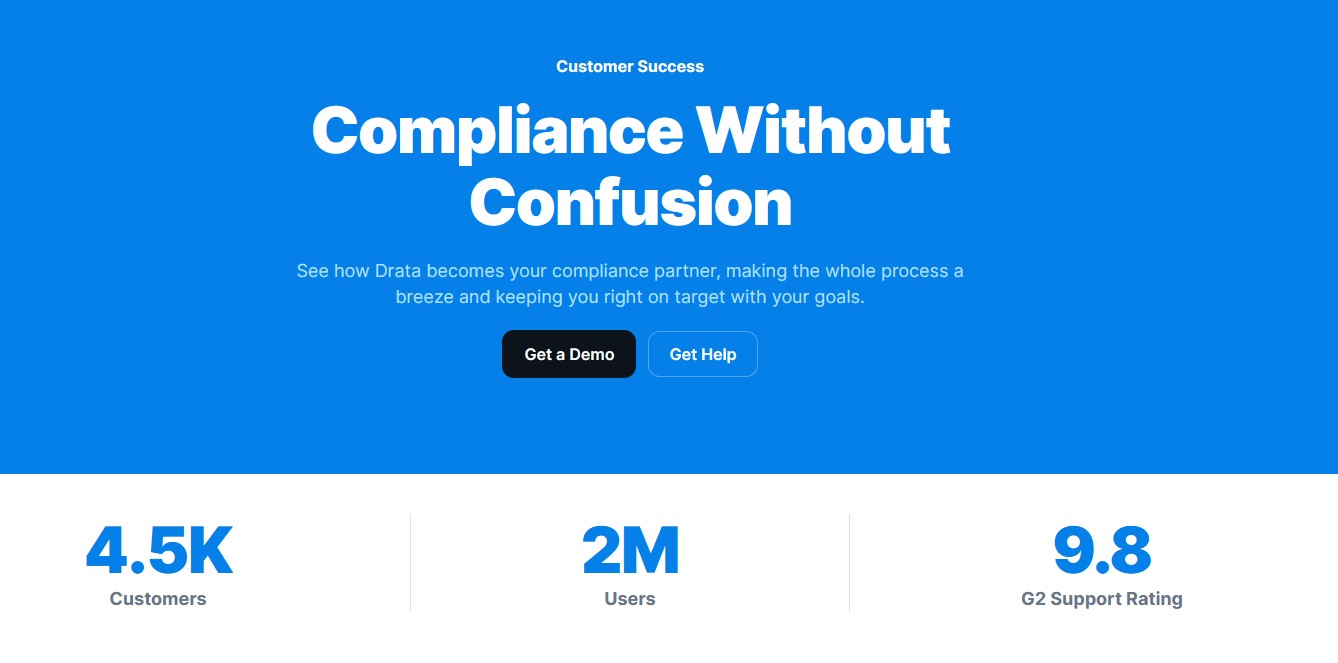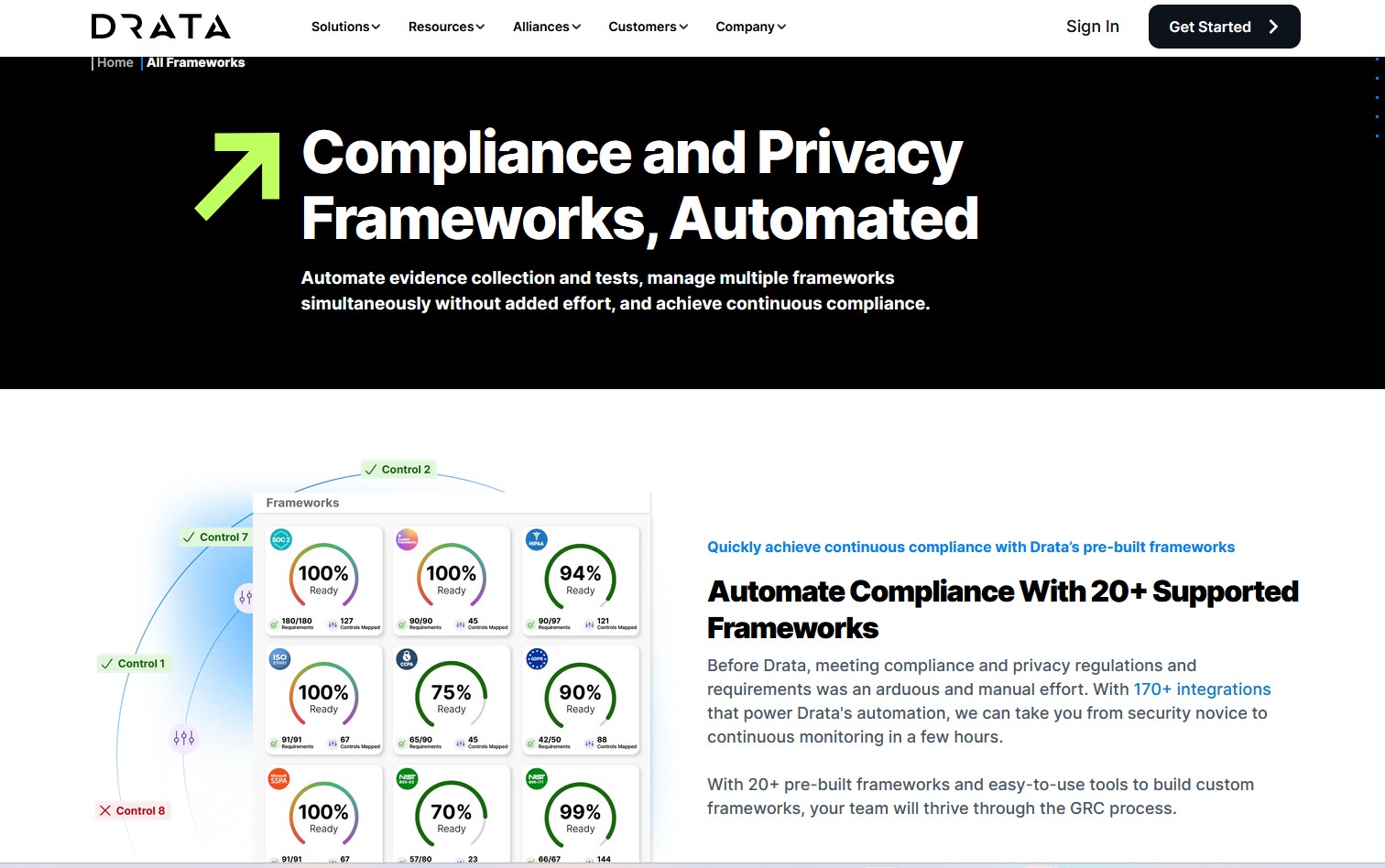A robust compliance management tool is crucial for organizations aiming to meet standards like HIPAA and SOC 2. The function of GRC tools like these runs the gamut from defining roles and responsibilities to establishing monitoring mechanisms and communication channels. This makes it easier for auditing bodies and organizations to work together and stay on track with compliance goals.
Drata Overview (FREE TRIAL, DEMO)
This article aims to provide a thorough examination of Drata‘s unique features, benefits, drawbacks, and target audience. By delving into reviews, conducting independent research, and exploring demos and documentation, our goal is to shed light on what sets Drata apart from other compliance management tools.
Drata is designed to meet the compliance needs of a wide range of organizations. It offers a sturdy foundation for achieving and maintaining compliance across different regulatory environments and frameworks. Drata empowers organizations to navigate complex regulatory landscapes with AI-driven processes, thoughtful and thorough policy templates, and some of the fastest setup times in the compliance software space.
Key Features of Drata
Drata customers tend to appreciate the tool’s robust features, intuitive interface, and exceptional customer support. Drata’s implementation and configuration times are the shortest in the industry, with some customers reporting implementation times as low as 4 weeks, and configuration times as low as 15–30 minutes.
Here is a list of key features that position Drata as a valuable asset for businesses:
- Comprehensive Compliance Monitoring: Ensures organizations remain audit-ready and proactive in risk management.
- Prewritten Policy Templates: Provides audit-ready documentation with customizable templates, saving costs on technical writing reviews.
- Structured Onboarding and Responsive Customer Support: Fast and efficient implementation, with hands-on customer support available 24/7.
- Integration and Scalability: Integrates with 120+ tools and systems, offering flexibility and accommodating growth over time.
- Customizable Trust Center: Provides added flexibility for tailoring compliance solutions to specific organizational needs.
- Centralized Document Management and Clear Compliance Roadmap: Reduces clutter and improves accessibility for auditors and employees alike.
Pros:
- Efficient Implementation: Streamlined process with staged onboarding steps.
- Cost-Effective Templates: Audit-friendly templates save costs on technical writing reviews.
- Operational Efficiency: Integrated approach with SaaS ecosystems reduces operational time.
- Supports Multiple Compliance Frameworks: Offers flexibility to comply with various regulatory standards.
- Enhanced Accessibility: Centralized document management improves accessibility for all stakeholders.
- Clear Compliance Progress: Provides a clear roadmap for compliance progress.
Cons:
- HITRUST Framework Absence: Lack of a built-in HITRUST framework requires manual workarounds.
- Limited Third-Party Integrations: Falls short compared to competitors in terms of integration capabilities (competitors like Vanta integrate with 300+ other tools).
- Visibility of Recurring Tasks: Improvement needed for enhanced task visibility.
- Complexity for New Users: Feature complexity may overwhelm new users.
- User-Friendly Improvements: Policy editor could be more intuitive.
- Configuration Limitations: Free trust center lacks configurability.
- Custom Framework Implementation: Requires significant effort and extra cost.
Pros and Cons of Drata
Users consistently praise the software’s proficiency in handling policy and risk management tasks, particularly in the realm of HIPAA compliance. Drata is often commended for its straightforward setup process, customizable features, and the proactive approach of the Drata team in enhancing the platform continually based on user input. Drata’s real-time monitoring capabilities across various controls and tests are held in high regard by users.
For all its positive qualities, Drata does have some limitations when compared to competing tools. For example, the absence of a pre-built Health Information Trust Alliance (HITRUST) framework. Users that need to comply with the HITRUST framework have to manually upload and map a workaround solution with hands-on assistance from Drata’s team. The workaround that exists is effective, but can be pricey for those already very sensitive to cost.
Comparison with Competitors
Drata’s compliance management tool competes with Vanta for the title of largest player in the space. Secureframe follows at a distant third.
Drata vs. Vanta
Vanta, a prominent player in the compliance management sphere, provides organizations with a comprehensive solution for navigating intricate regulatory landscapes. With its automated processes, continuous monitoring, and extensive integration options, Vanta serves as a valuable tool for businesses aiming to streamline compliance efforts. However, when comparing Drata to Vanta, several distinctions emerge:
Drata’s security features are tailored to assist businesses in achieving compliance with SOC 2, HIPAA, GDPR, and ISO standards. Drata is known for its user-friendly setup process and effective administration. The tool is additionally known for its ability to meet regulatory requirements while offering customization options, continuous enhancements, and seamless integration capabilities.
While both Drata and Vanta offer swift setup processes, Drata’s reputation for policy and risk management features, as well as ease of setup, stands out. Some users may find that Drata requires additional support interventions post-implementation compared to Vanta.
Drata vs. Secureframe
Secureframe, another contender in the compliance management landscape, focuses on streamlining SOC 2 and ISO 27001 compliance for companies. It offers a rapid compliance achievement process, monitoring over 40 services, including AWS, GCP, and Azure. However, when evaluating Drata against Secureframe, certain factors come into play:
While Secureframe is a reliable solution for achieving compliance within a shorter timeframe, it lacks the breadth of features and customization options offered by Drata. Drata’s emphasis on a structured onboarding process, comprehensive compliance monitoring, and centralized document management sets it apart from Secureframe. Additionally, Drata’s ability to integrate with 120+ tools along with its customizable trust center provide organizations with the flexibility needed to adapt to evolving compliance needs, a feature that Secureframe may lack.
Drata vs. Compliancy Group
Compliancy Group specializes in HIPAA compliance, offering guided software and dedicated Compliance Coaches™ to assist clients through the compliance process. While Compliancy Group excels in facilitating annual risk assessments and streamlining compliance processes, its limited learning management system (LMS) and lackluster urgent support may pose challenges for some organizations.
In contrast, Drata offers a more comprehensive approach to compliance management, covering multiple regulatory frameworks beyond HIPAA, and providing robust integration capabilities and responsive customer support.
Drata vs. Protecht Group
Protecht Group’s enterprise risk management software, Protecht.ERM, embeds risk and compliance matters across different business units. The tool centralizes risk information and generates reports to streamline existing processes.
While Protecht Group’s responsive support team and centralized database enhance collaboration and decision-making, Drata’s user-friendly interface and structured onboarding process may appeal to organizations seeking a more intuitive and efficient compliance management solution.
Drata vs. Alyne by Mitratech
Alyne by Mitratech is a SaaS software designed to enhance cybersecurity, risk management, and compliance capabilities for organizations of all sizes and industries. It facilitates the definition of common rules, assessment of adherence, and identification of related risks, supporting organizations in implementing legal and regulatory requirements, determining maturity, and aligning with industry standards.
While Alyne offers a comprehensive solution for compliance management, Drata distinguishes itself with its robust security platform features, tailored setup process, and customizable policies. Drata’s customer base is much larger than that of all of these tools (except for Vanta).
Target Audience for Drata
Drata is tailored for medium and large startups, large enterprises, and auditors committed to meeting compliance standards, especially SOC 2 and similar requirements. It prioritizes security over cost within the realm of HIPAA compliance software and aims at enhancing existing compliance frameworks effectively, regardless of the organization’s current stage in their compliance journey.
Drata’s target market encompasses several sectors:
- Automation Seekers: Drata caters to organizations actively seeking solutions to automate and streamline their compliance processes, as highlighted in the article.
- Startup and SMB Environments: The article suggests that Drata appeals to startups and SMBs embarking on compliance journeys, particularly those without dedicated compliance teams.
- Tech-Forward Enterprises: Drata’s ability to integrate with popular platforms like GitHub and Amazon Inspector indicate a focus on tech-savvy businesses reliant on such tools for operations and compliance endeavors.
- Heavily Regulated Industries: The mention of achieving SOC 2 compliance implies that Drata targets companies within regulated sectors like technology, finance, or healthcare, where adherence to standards like SOC 2 is paramount.
- Organizations with Global Reach: Drata’s appeal extends to businesses worldwide. Their myriad compliance frameworks businesses in the USA and abroad to navigate foreign regulatory landscapes such as GDPR in Europe.
Detailed Analysis of Drata’s Features
Drata’s automated compliance monitoring streamlines regulatory tasks, ensuring organizations uphold standards and demonstrate ongoing compliance with precision and efficiency. This feature minimizes the risk of data breaches and regulatory penalties by proactively managing risks and maintaining audit readiness. With Drata’s comprehensive monitoring, organizations can stay ahead of regulatory changes and emerging threats, enhancing overall security posture and resilience.
In addition to monitoring, Drata offers pre-canned policies and templates, simplifying compliance efforts and ensuring consistency in documentation. This reduces technical writing costs and streamlines compliance processes with common language and common formatting. Drata’s structured onboarding and responsive support further contributes to swift implementation and efficient utilization of the platform.
With over 120 integrations available, Drata seamlessly pairs with various tools and systems that offer any compliance-adjacent business flexibility and efficiency in meeting regulatory requirements. This interoperability streamlines compliance processes, enhancing overall operational efficiency. Additionally, Drata’s customizable trust center empowers organizations to tailor compliance solutions to their specific needs, providing flexibility and adaptability.
Combined with centralized document management and a clear compliance roadmap, Drata ensures organizations can navigate compliance frameworks easily. Drata’s user-friendly interface enables organizations to adopt and utilize the platform without extensive training or technical expertise, ultimately improving organizational productivity and compliance posture.
Pricing
Drata offers pricing plans that span from $20,000 to $100,000, contingent upon variables such as company size and the chosen compliance framework. Despite potentially higher costs compared to some competitors, Drata stands out for its swift implementation process and extensive customer support. This is particularly valuable when businesses are under pressure to achieve compliance swiftly, as is often the case with regulatory standards like HIPAA and SOC 2. In such scenarios, Drata proves to be a wise investment for organizations that prioritize both efficiency and compliance.
In comparison. Compliancy Group’s pricing structure begins at $3,000 for managed service providers (MSPs), with monthly fees ranging from a few hundred to several thousand dollars per client for smaller businesses employing fewer than 25 staff members. In the same vein, Protecht Group’s compliance software, Protecht.ERM, commands an annual fee starting at a staggering $45,000—a substantially higher starting point compared to Drata’s pricing model. All that said, Drata is less affordable than other options, including its biggest competitor, Vanta.
Integration and Scalability
While Drata has more limited integration capabilities than competitors like Vanta, the tool boasts a still-impressive 120+ integrations with tools that businesses use every day. This may seem like a lot, but some competitors integrate with over 300 platforms and tools. Drata compensates for its narrower integration options with robust scalability options to accommodate growth and evolving compliance needs over time.
Vendor Reputation and Support
Drata maintains a solid standing in the compliance and risk management industry. Its support services are known for quality and responsiveness, providing customers with efficient technical assistance and timely software updates. Customers praise the software’s comprehensive compliance monitoring capabilities, with many reporting quick setup times, some as short as 15 to 30 minutes.
With approximately 3,500 customers and an annual recurring revenue (ARR) of around 50 million dollars, Drata maintains its position as a key player in the compliance monitoring market, offering tailored solutions for varied organizational needs.
Conclusion: Why Choose Drata?
As businesses aim to meet standards like HIPAA and SOC 2, Drata stands as a trusted ally, ready to support them confidently through their compliance journey. Drata offers a robust solution for organizations navigating compliance complexities. Despite identified areas for improvement such as expanded integrations and the inclusion of frameworks like HITRUST, Drata’s strengths are obvious.
Users of Drata appreciate its intuitive interface, customizable features, and efficient implementation process. Whether you are a startup establishing a compliance foundation or a large enterprise enhancing existing security measures, Drata’s comprehensive monitoring, templated policies, and responsive support make it a compelling choice.
